"I love Patek Philippe perpetual calendars only marginally more than I dig the Casio Frogman G-Shock – but for different reasons – and if you’re wearing either, chances are I’ll sidle over to you and start a conversation about it."
– John Mayer, HODINKEE, 2012The G-Shock is a lot of things – the world's toughest watch; arguably its most practical; in some versions, arguably its ugliest. It is also, however – as John Mayer's remark above, from 2012, so pithily underscores – a watch that has achieved what as far as I can tell is a unique degree of crossover status. It's the one quartz multifunction watch likeliest to be appreciated for its qualities by otherwise diehard mechanical watch fans, and it's full of technical qualities that you have to admire from an engineering standpoint, even if you wouldn't be caught dead with one on your wrist. It would be difficult to say for sure without the sort of meticulous statistical analysis that only organizations like the NSA, or major pharmaceutical companies, can afford, but it's probably the single most-often-chosen watch for people who need a watch, and need it to be able to tolerate considerable abuse, as well – soldiers, rescue workers, police officers, and the like.

It has also, however, become the focus of a worldwide community of G-Shock collectors, as well as a pop-culture staple, having appeared in films, music videos, and live performances too numerous to mention. The only other watches that I can think of offhand that combine the G-Shock's reputation for toughness and mechanical reliability with pop culture and Hollywood superstar status, are probably watches from Rolex, and as different from each other as they might seem (and are, of course, in virtually every physical respect) I've often thought that they're both as popular as they are in the U.S., at least, for similar reasons. What both watches have in common, in addition to their reputation for toughness and reliability, is their ability to project their respective identities in an instantly identifiable fashion, and for a watch, or for that matter, any luxury object, to succeed in becoming an element of mass culture, it has to be instantly recognizable, more or less. (Just ask Jean-Claude Biver, who understands very well that when it comes to luxury, winning a popularity contest often means winning a visibility contest first.)

In certain respects, therefore, the G-Shock is sort of ripe for appropriation as a higher end luxury object. Of course, as is often the case with appropriation of street to luxury, the pop music world was there first – quite a lot of one-off customized G-Shocks have been seen on quite a few famous wrists over the years, including Pharrell Williams' gold-cased BAPE DW-6900; for the 25th anniversary party for G-Shock in New York the likes of Kanye West and Spike Lee showed up. All this led up to the inevitable: the creation, last year, of a one-off solid gold DW5600.
As fascinating as the unlikely, and decade-long (or more) success of the G-Shock as a piece of jewelry is, the fact remains that the ornamentation was very much in a European or American style. Even the G -Shock in solid gold, which wasn't an aftermarket modification, but something actually designed and sanctioned by G-Shock creator Kikuo Ibe himself, seems very much a product of an Americanized design sensibility. In any case, and for whatever reason, Casio decided to make a luxury-leaning version of its most relentlessly practical watch that was as Japanese in its ornamentation as the G-Shock itself is in its origin.
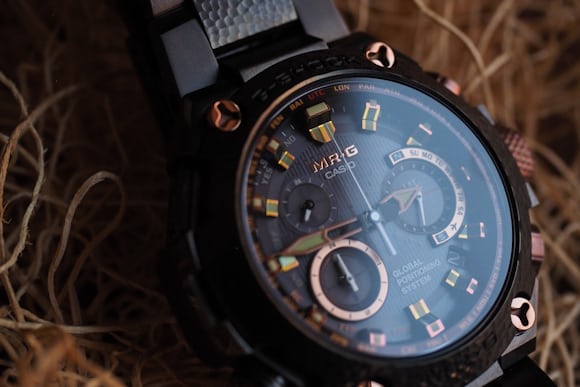
Before going any further into the decorative aspects of the Hammer Tone – designated MRGG1000HT – let's talk a little more in depth about its technical aspects. First of all, this is a G-Shock; the original G-Shocks were built to tolerate a 10-meter drop, have 10-bar water resistance, and have a 10-year battery life and this still remains the minimum standard for all watches that call themselves G-Shocks. The MRGG1000HT (HT for Hammer Tone) is based on the various MRGG1000 models, which are among the most technically advanced (and, for a G-Shock, the most expensive) G-Shock watches. Typically G-Shocks have used backlit LCD screens, but in recent years, Casio's been making them with analog hands as well, and the MRGG1000 watches have analog-only displays, which if you're a decades-long G-Shock user like me takes a little getting used to. Home time is shown on a sub-dial at 8:00; the main hour and minute hands show local time, and the dial at 10:00 shows 24 hour time.
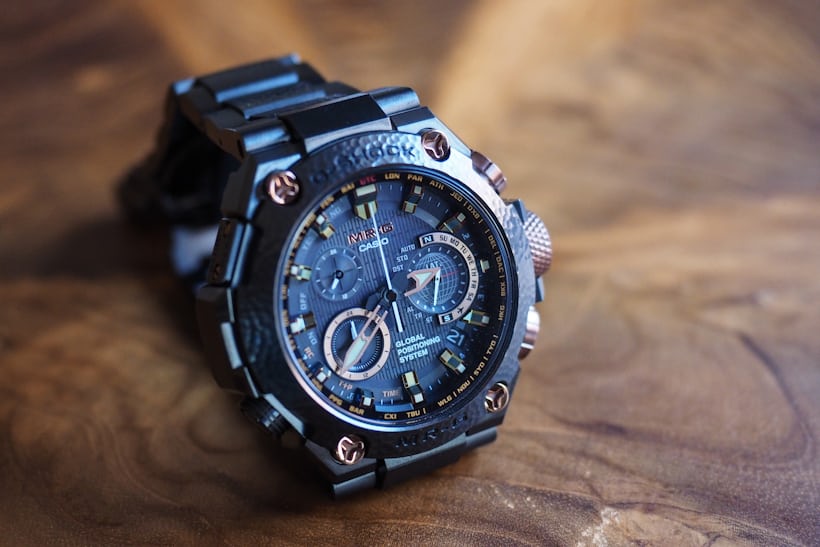
The dial at 3:00 has several functions and depending on the mode you've selected, either shows the day of the week; the latitude at which you've taken your most recent time fix from the GPS system; whether or not the watch is in airplane mode; and whether or not you're set to summer or winter time. It can also function as a mode indicator, showing whether you're in alarm, stopwatch, or countdown timer mode.
One of the most interesting features of the Hammer Tone and the MRGG1000 watches on which it's based, is its use of the GPS satellite network to establish correct location and correct time for that location automatically. Of course the Hammer Tone isn't the only watch to use the GPS network for this purpose; the Seiko Astron and Citizen Satellite Wave watches both use the GPS network as well, but watches using the GPS system are still somewhat rare and technically very interesting. GPS watches work like any other GPS receiver: four satellites have to be in view in order for the time to be set correctly as three position coordinates are required, and one additional signal to compute the deviation of the clock on the ground from the atomic clocks on board the GPS satellites (which are themselves corrected by ground based atomic clocks). However, if the MRGG1000 watches are unable to obtain the time from the GPS system, they can use national time-broadcasting radio signals such as those found in Europe, the U.S., and Japan in order to obtain the correct time – and if all else fails, they are of course autonomous quartz timekeepers as well (and the Hammer Tone is solar powered as well).
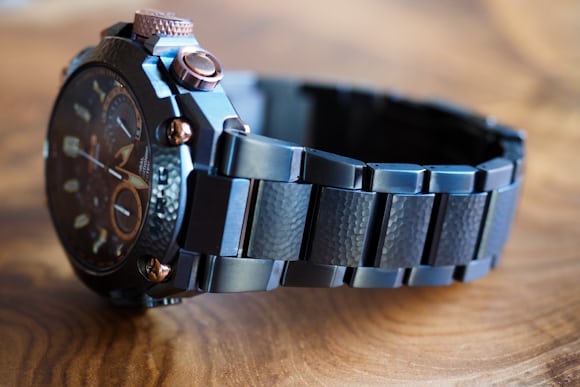
What really sets the Hammer Tone apart from any other G-Shock – and for that matter, from pretty much any other watch I can think of, period – is its use, not of conventional forms of horological ornamentation, and especially not of ones based in European cultural norms, but rather of decorative methods and materials that are native to Japan. We've gone over some of the details in our previous coverage of the Hammer Tone, but here's a recap: the watch is made largely of titanium, but with considerable additional work given to decorating it above and beyond anything Pharrell or Kanye might ever have imagined. The decorative technique is called tsuiki, and as we mentioned in our introduction to the watch some weeks ago, it consists of painstaking striking a metal surface with a hammer in such a way as to leave a pattern of tiny indentations (the technique is often found in traditional Japanese arms and armor). The technique creates a seemingly random pattern, yet despite its random nature it takes years of practice to be able to achieve the seemingly natural, artless effect – something intrinsic to much of the Japanese decorative arts from painting, to calligraphy, to ikebana (flower arranging).
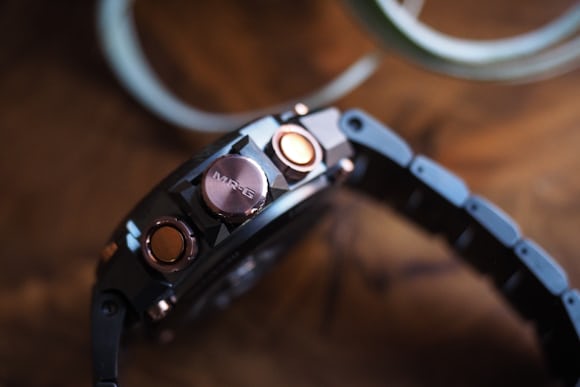
The tsuiki pattern (applied by tsuiki master Bihou Asano, who has created ornaments for the Kyoto State Guest House) is directly applied to the titanium bezel and center links for the bracelet, which are then hardened to make them 4-5 times harder than conventional titanium. The last step is to apply DLC coating to areas where a darker finish is desired, and a decorative metal coating to other areas. Most notably, the Hammer Tone uses oborogin, a silver and copper alloy; and akagane, a copper and gold alloy, to finish certain case parts, as well as the crown and pushers. Despite the rather hefty dimensions of the watch, and the impression you get at first that this is going to be a bulky affair in the hand and on the wrist, the whole watch is eerily light, thanks to the considerable use of titanium in its construction (and of course, the use of composites for the inner shock and impact shielding for the movement). As with all G-Shocks, the dial can be illuminated at night; since there's no LCD display to backlight, the dial is lit, rather theatrically, by a sort of LED footlight at 6:00.

The Hammer Tone is an immensely confusing watch to encounter because it doesn't really fit in anywhere. There is a huge range of conceptual categories into which watches can fit, so as a rule we don't very often see a watch that refuses to seem appropriate for any of them, which makes life very difficult because the way most of us judge a watch is by how well it fits our preconceived notion of what any given type of watch should be. We all have our idea of what the ur-chronograph is, or the ur-dive watch, or the ur-dress watch (which is part of the problem with watch criticism from both specialist writers and enthusiasts; most of the time, without realizing we're doing it, we're really judging a watch on the basis of its adherence to our deeply held and typically, quite inflexible personal prejudices rather than evaluating it on its own terms).
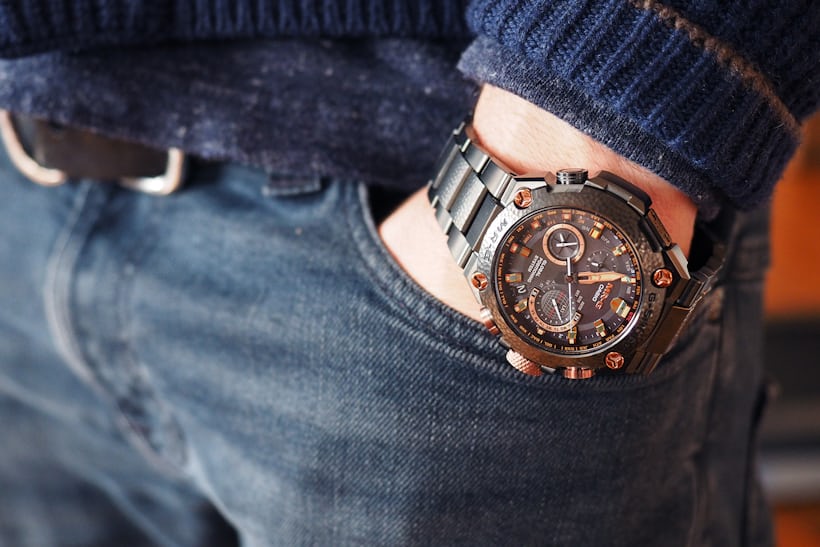
This is nominally a G-Shock, but it's obviously a tremendous departure from any produced to date (or at least, any series produced G-Shock to date) and it also resolutely refuses to fit any of the usual stereotypes of a blinged-out, low-end quartz watch, such as we've seen both in their more honest form (say what you like about gem-set Technomarines, at least they weren't pretending to be anything they're not) and in their more covert (any number of carelessly made and exorbitantly priced so-called ladies' watches, for instance). It also happens to be very well made; the technology is right now, up to the minute for an externally controlled quartz watch and in 50 years, given that it's a G-Shock there's an excellent chance it will still be running. Like all machines, it'll expire at some point but at least it will have the somewhat mournful appeal of once cutting-edge, obsolescent technology. More than that, it's physically made very well; both the tsuiki decoration and the machining of the case and other elements are, judged by the designer's apparent intentions, hard to fault.

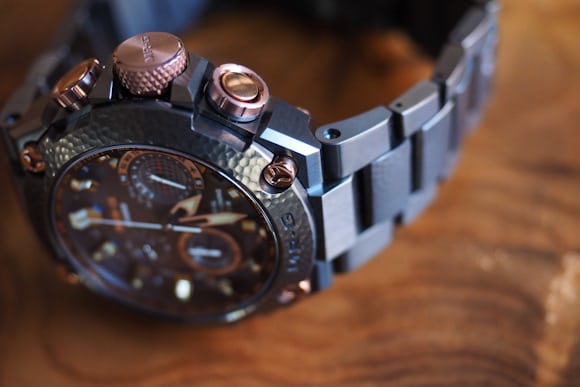
Japan, famously, or at least famously to Western and American eyes, is a place where incredible cultural extremes can coexist, and there's a profound commitment to the cultural identity to be found in its adherence to ancient norms and forms on the one hand, and an incredible fascination with technology and modernity on the other. Based on the reaction to our earlier introduction to the Hammer Tone (and the jolt of reading about a G-Shock that costs $6,200) I wonder if some readers mightn't think I'm pulling their legs a little bit with this review, but there's something, to me, deeply fascinating about this watch. What unifies every part of it is a certain single-mindedness – the pursuit of the most advanced timekeeping technology, the most exacting hand decoration techniques, the most visually and graphically striking design. It's nominally a watch, and nominally a G-Shock – and it'll perform well in both roles – but what it really is, is a collision of many different worlds brought together by a single obsessive fascination with what happens when you take seemingly completely divergent and even contradictory worlds to their extremes in one object. What you get is something that could have come from nowhere else than Japan, and probably, a watch that couldn't have come from anyone other than Casio.
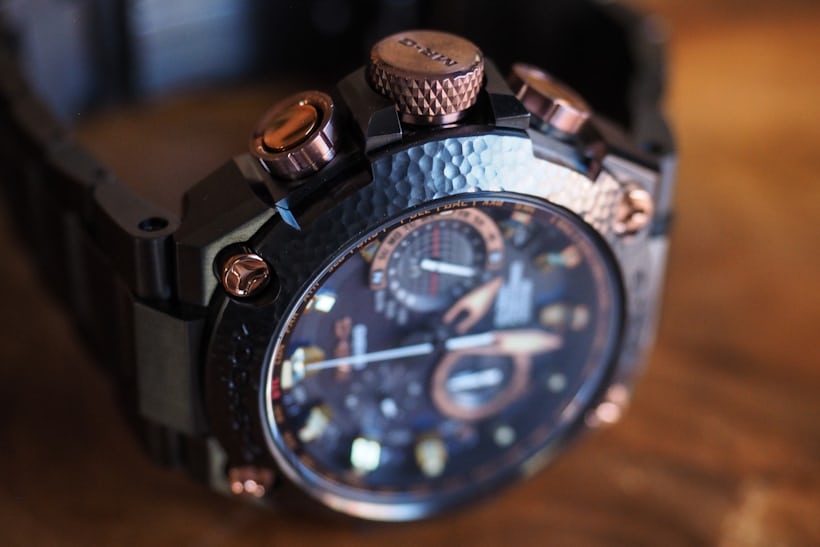
Read more about the MRG G-Shocks from Casio here.
For full specs and first impressions, as well as pricing, check out our First Look coverage of the Hammer Tone here.
Don't have the HODINKEE App yet? Get years of amazing watch content plus new stories, breaking news, and access to great new features like HODINKEE Live, free on iOS.
No comments:
Post a Comment